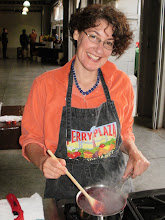Clouds so swift and rain falling in...
The first entry in this year's Hamentaschen Sweeps comes from Raymond Sokolov's The Jewish American Kitchen. (Actually, according to the credits on the cover, Susan Friedland did the recipes for this book, so we'll say thanks to Susan first. Thanks, Susan!) The ingredient list may look like every other cookie dough on the planet, but check out the method. Instead of creaming the butter and sugar, adding the eggs, then stirring in the flour, this dough is made like a rich tart pastry. The butter is cut into the flour, then the eggs and lemon rind are stirred in to make a soft, rich dough.
Now, the caveats. Even though I chilled the dough very well, it was really, really sticky when I went to roll it out. If this happens to you too, be sure to flour your counter really well. I tossed some flour over a sheet of wax paper, sprinkled a little more flour over the dough, then topped with another piece of paper. This solved the rolling problem, but the dough was still so soft it was hard to cut out. I pretty much had to imprint circles on the dough, scrape them off the paper with a spatula, sprinkle each one with flour, then hand-pat the crumpled dough wads into more-or-less even circles. But once baked, they looked cute and were so buttery-lemony and delicious that any amount of fuss was worth it.
And a question: has anyone ever had yeast-raised hamentaschen? Presumably, these pre-date the chemically-leavened ones we're familiar with today. I've never had them, but recipes (usually for a brioche-style dough enriched with milk, butter, and eggs) turn up in many books; they sound like a wonderful breakfast treat.
Susan's Hamentaschen
2 cups flour
1/2 cup sugar (can increase if you like a sweeter cookie, to 2/3 cup)
1 tsp baking powder
pinch salt
1/2 cup (4 oz/1 stick) cold butter, cut into cubes
2 eggs, beaten
2 tsp finely grated lemon rind
Apricot and/or prune filling (see below)
Egg wash (1 egg beaten with 1 TB water)
Sift or whisk flour, sugar, baking powder, and salt together. Cut in cold butter as if making pastry, using a food processor or a pastry blender. Dough should look pebbly. Pour beaten egg into a measuring cup or small pitcher and add to flour mixture a little at a time. Mix and add egg until a soft dough is formed. You may not need all the egg; you want your dough to hold together well but not be so moist you can't roll it out. Mix in lemon rind. Form into a ball, wrap tightly and chill well--at least several hours or overnight.
Preheat oven to 350 F. Roll out dough on a well-floured board or between two pieces of wax paper--it should be a little thicker than you'd use for pie pastry. Using a glass or a biscuit cutter, cut dough into 2- to 3-inch circles. Lift circles onto an ungreased baking sheet. Scoop a dab of apricot or prune filling onto each circle, then fold sides in and bottom up to form a triangle with a small peek of filling showing in the center. Using a pastry brush, brush dough lightly with egg wash. Bake 15-20 minutes, until pale golden brown. Let cool on a rack, keeping in mind that filling is VERY hot when first removed from the oven. They are delicious warm, but give that filling a little time to cool off first. Makes around 20-30 cookies, depending on size.
Apricot Filling
Why this, and not jam? Because jam is way too wet, and will make your cookies soggy.
7 oz. apricot paste (available in Middle Eastern grocery stores)
1/8 cup lemon juice
1/8 cup orange juice
scant 1/4 cup sugar
1 cup golden raisins
Pull apricot paste into pieces. Put pieces into a small, heavy-bottomed pot with juices, sugar, and raisins. Simmer over very low heat for 10-12 minutes, until apricot paste is softened and raisins are plump. Stir frequently to keep from scorching. Remove from heat, let cool for 10 minutes, then puree. This makes enough for several batches of cookies, with some left over for toast. Kept in a covered jar in the fridge, it lasts a very long time.
Prune Filling
2 cups pitted prunes
1 cup raisins
1/3 cup lemon juice
1/4 cup orange juice
1/2 cup water
1/4 tsp cinnamon
Mix ingredients in small, heavy-bottomed pot. Follow instructions, above, cooking until prunes are softened and raisins are plumped. Cool and puree as above.
Subscribe to:
Post Comments (Atom)

4 comments:
I tend to throw cream cheese into my hamentaschen dough in addition to butter, since I have to make it eggless (I put in a little tapioca). I think it's the secret to more delicious hamentaschen. I also make a killer chocolate filling with cocoa, oat flour, butter, almond extract and sugar, in unspecified quantities.
Yum! that sounds delicious--like rugalach!
Stephanie,
You asked "has anyone ever had yeast-raised hamentaschen? Presumably, these pre-date the chemically-leavened ones we're familiar with today."
There maybe one out there, but Hamentaschen is a traditional dessert for Purim (AKA PASSOVER). The passover story stresses the Exodus of the Jewish people out of Egypt: they had to leave so fast they they did NOT have time to use yeast to make the product rise, since with yeast you have to let it rise twice and press it thrice.
The Jewish custom/laws demand that you not use yeast to leaven any item you cook during the Passover Celebration.
Any Yeast Leavened item would not be served or retained in a Jewish household that observes the Purim (Passover) celebration.
Actually, Guyitay, Purim and Passover are two different holidays, celebrating completely different historical events. Purim generally takes place about a month before Passover, so the leavening restrictions of Passover don't apply. It's always a good idea to check your facts before making a correction!
Post a Comment